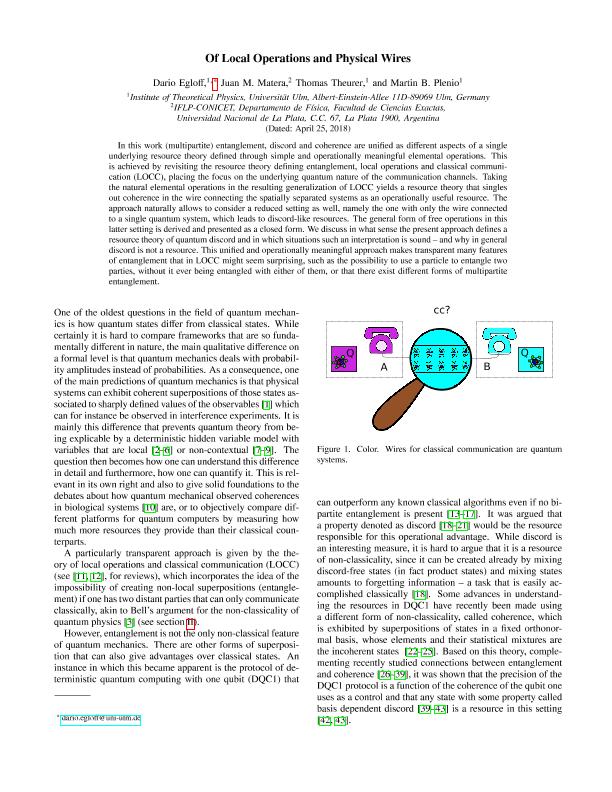Mostrar el registro sencillo del ítem
dc.contributor.author
Egloff, Dario

dc.contributor.author
Matera, Juan Mauricio

dc.contributor.author
Theurer, Thomas
dc.contributor.author
Plenio, Martin Bodo

dc.date.available
2020-03-27T16:13:22Z
dc.date.issued
2018-07
dc.identifier.citation
Egloff, Dario; Matera, Juan Mauricio; Theurer, Thomas; Plenio, Martin Bodo; Of Local Operations and Physical Wires; American Physical Society; Physical Review X; 8; 3; 7-2018; 1-21
dc.identifier.issn
2160-3308
dc.identifier.uri
http://hdl.handle.net/11336/101062
dc.description.abstract
In this work (multipartite) entanglement, discord, and coherence are unified as different aspects of a single underlying resource theory defined through simple and operationally meaningful elemental operations. This is achieved by revisiting the resource theory defining entanglement, local operations, and classical communication (LOCC), placing the focus on the underlying quantum nature of the communication channels. Taking the natural elemental operations in the resulting generalization of LOCC yields a resource theory that singles out coherence in the wire connecting the spatially separated systems as an operationally useful resource. The approach naturally allows us to consider a reduced setting as well, namely, the one with only the wire connected to a single quantum system, which leads to discordlike resources. The general form of free operations in this latter setting is derived and presented as a closed form. We discuss in what sense the present approach defines a resource theory of quantum discord and in which situations such an interpretation is sound - and why in general discord is not a resource. This unified and operationally meaningful approach makes transparent many features of entanglement that in LOCC might seem surprising, such as the possibility to use a particle to entangle two parties, without it ever being entangled with either of them, or that there exist different forms of multipartite entanglement.
dc.format
application/pdf
dc.language.iso
eng
dc.publisher
American Physical Society

dc.rights
info:eu-repo/semantics/openAccess
dc.rights.uri
https://creativecommons.org/licenses/by-nc-sa/2.5/ar/
dc.subject
QUANTUM INFORMATION
dc.subject
QUANTUM COMMUNICATION
dc.subject
RESOURCE THEORIES
dc.subject.classification
Física Atómica, Molecular y Química

dc.subject.classification
Ciencias Físicas

dc.subject.classification
CIENCIAS NATURALES Y EXACTAS

dc.title
Of Local Operations and Physical Wires
dc.type
info:eu-repo/semantics/article
dc.type
info:ar-repo/semantics/artículo
dc.type
info:eu-repo/semantics/publishedVersion
dc.date.updated
2020-03-25T13:45:40Z
dc.journal.volume
8
dc.journal.number
3
dc.journal.pagination
1-21
dc.journal.pais
Estados Unidos

dc.journal.ciudad
College Park
dc.description.fil
Fil: Egloff, Dario. Universität Ulm. Faculty of Natural Sciences. Institute of Theoretical Physics; Alemania
dc.description.fil
Fil: Matera, Juan Mauricio. Consejo Nacional de Investigaciones Científicas y Técnicas. Centro Científico Tecnológico Conicet - La Plata. Instituto de Física La Plata. Universidad Nacional de La Plata. Facultad de Ciencias Exactas. Instituto de Física La Plata; Argentina
dc.description.fil
Fil: Theurer, Thomas. Universität Ulm. Faculty of Natural Sciences. Institute of Theoretical Physics; Alemania
dc.description.fil
Fil: Plenio, Martin Bodo. Universität Ulm. Faculty of Natural Sciences. Institute of Theoretical Physics; Alemania
dc.journal.title
Physical Review X
dc.relation.alternativeid
info:eu-repo/semantics/altIdentifier/url/https://link.aps.org/doi/10.1103/PhysRevX.8.031005
dc.relation.alternativeid
info:eu-repo/semantics/altIdentifier/doi/http://dx.doi.org/10.1103/PhysRevX.8.031005
Archivos asociados
